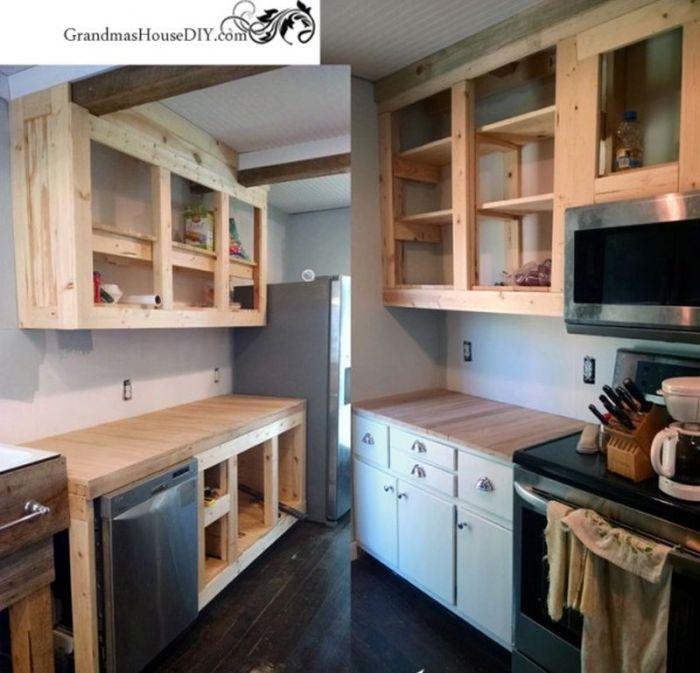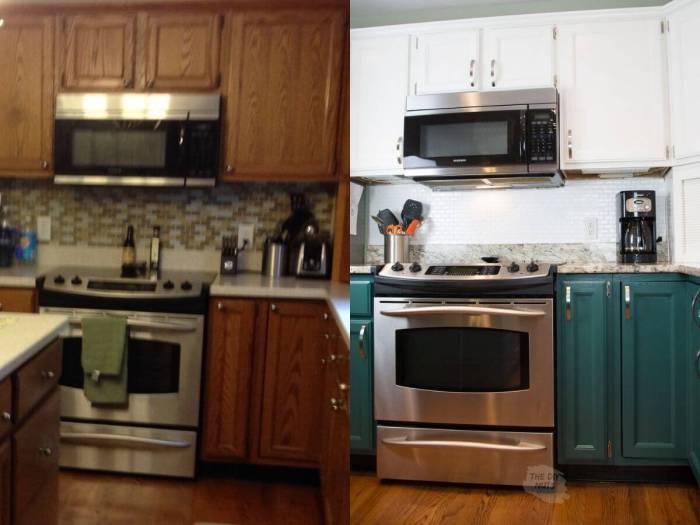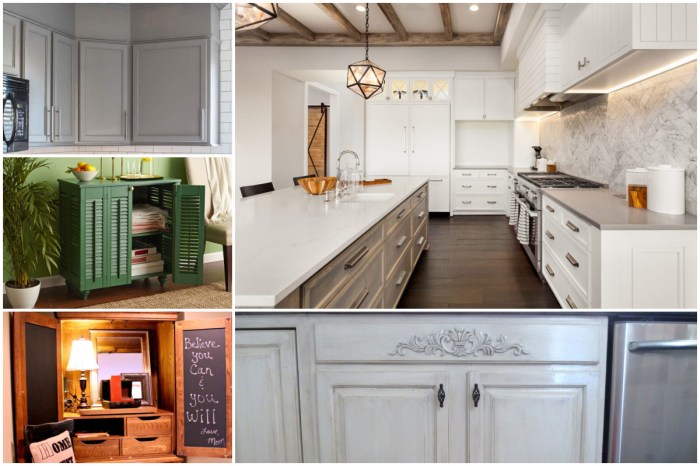DIY kitchen cabinets ideas can transform your kitchen into a personalized space that reflects your style and needs. Whether you’re a seasoned DIYer or a beginner, building your own cabinets offers a rewarding experience that allows you to create custom solutions for your kitchen’s unique layout and design preferences. This comprehensive guide provides step-by-step instructions, tips, and inspiration to help you embark on your kitchen cabinet building journey with confidence.
Table of Contents
From planning and design to installation and finishing, we’ll cover all the essential aspects of building DIY kitchen cabinets. We’ll explore different cabinet styles, materials, and construction techniques, along with practical advice on budgeting, time management, and safety. With a little planning and effort, you can create beautiful and functional kitchen cabinets that enhance your home’s aesthetics and functionality.
Planning and Design: Diy Kitchen Cabinets Ideas

Building kitchen cabinets is a rewarding DIY project that can transform your kitchen. However, proper planning and design are crucial for a successful outcome. Careful consideration of your needs, space, and budget will ensure a functional and aesthetically pleasing result.
Kitchen Layout and Measurement
Accurate measurements are essential for creating cabinets that fit perfectly in your kitchen. Start by sketching a detailed floor plan of your kitchen, including all walls, windows, doors, appliances, and existing cabinets. Measure the width, height, and depth of each area where you plan to install cabinets. Be sure to account for any obstructions, such as pipes, electrical outlets, or structural beams. Consider the placement of appliances, sinks, and other fixtures to ensure a comfortable and efficient workflow.
Cabinet Styles and Materials
Choose cabinet styles and materials that complement your kitchen’s design and meet your functional needs. Some popular cabinet styles include:
- Shaker: Simple, clean lines with recessed panels, offering a timeless and versatile look.
- Traditional: Features ornate details, raised panels, and decorative hardware, creating a classic and elegant ambiance.
- Modern: Characterized by sleek lines, flat panels, and minimalist hardware, reflecting a contemporary aesthetic.
Common materials for DIY cabinets include:
- Plywood: Strong, durable, and readily available, making it an excellent choice for cabinet boxes.
- Medium-density fiberboard (MDF): Offers a smooth, consistent surface suitable for doors and drawer fronts.
- Solid wood: Provides a natural and elegant look, but can be more expensive and require more maintenance.
Cabinet Design
Once you’ve determined your kitchen layout and chosen your materials, it’s time to design your cabinets. Consider the following factors:
- Cabinet size and configuration: Determine the number and size of cabinets needed to accommodate your storage needs. Consider different cabinet types, such as base cabinets, wall cabinets, and pantry cabinets.
- Door and drawer styles: Select door and drawer styles that complement your chosen cabinet style. Options include raised panel, flat panel, shaker, and more.
- Hardware: Choose knobs, pulls, and hinges that match your kitchen’s aesthetic. Consider functionality and durability.
- Finishing: Decide on a paint or stain finish that complements your kitchen’s decor. Consider the durability and ease of maintenance of different finishes.
Tools and Materials
To build your kitchen cabinets, you’ll need the following tools and materials:
- Tools: Table saw, circular saw, jigsaw, drill, sander, router, clamps, measuring tape, level, pencil, safety glasses, and dust mask.
- Materials: Plywood, MDF, solid wood, cabinet hinges, drawer slides, knobs, pulls, screws, glue, wood filler, primer, paint or stain, and finishing supplies.
Installation and Refinement

Installing kitchen cabinets is a rewarding step in your DIY project, allowing you to see your design come to life. This section will guide you through the process, from mounting wall cabinets to fine-tuning doors and drawers for seamless functionality.
Wall Cabinet Installation
Installing wall cabinets requires careful planning and execution to ensure they are level and securely mounted. Here’s a step-by-step approach:
- Mark the wall: Use a level and pencil to mark the desired height and location of each cabinet on the wall. Remember to consider the countertop height when determining the cabinet placement.
- Install mounting brackets: Secure mounting brackets to the wall at the marked locations. These brackets will provide a solid foundation for the cabinets.
- Mount cabinets: Carefully lift the cabinets into place and align them with the marked locations. Ensure they are level and plumb before securing them to the brackets.
- Level and adjust: Use a level to ensure the cabinets are perfectly level. You may need to adjust the mounting brackets slightly to achieve a level installation.
Base Cabinet Installation, Diy kitchen cabinets ideas
Base cabinets form the foundation of your kitchen and require proper installation to ensure stability and alignment. Here are the steps:
- Prepare the floor: Ensure the floor is level and free of debris before installing the base cabinets. Consider using a leveling compound if necessary.
- Install the first cabinet: Begin by installing the first cabinet in a corner or against a wall. Use shims to adjust for any unevenness in the floor.
- Connect subsequent cabinets: Connect the remaining cabinets to the first one using cabinet connectors. Ensure the cabinets are level and aligned before securing them together.
- Secure cabinets to the wall: Use screws or brackets to secure the base cabinets to the wall for added stability, especially in areas prone to earthquakes.
Aligning and Leveling Cabinets
Achieving a professional look requires precise alignment and leveling of cabinets. Here’s how:
- Use a level: Use a level to check the horizontal and vertical alignment of each cabinet. Make adjustments as needed using shims or by loosening and retightening mounting screws.
- Check cabinet gaps: Ensure consistent gaps between cabinets for a clean and polished appearance. Adjust the position of cabinets using shims or by loosening and retightening mounting screws.
- Measure and mark: Use a measuring tape and pencil to mark the desired locations for cabinets, ensuring consistent spacing between them. This will help maintain a cohesive and balanced look.
Adjusting Doors and Drawers
Properly adjusted doors and drawers ensure smooth operation and a sleek appearance. Here’s how to fine-tune them:
- Adjust hinges: Use a screwdriver to adjust the screws on the hinges to fine-tune door alignment. Ensure the doors open and close smoothly without any gaps or misalignment.
- Adjust drawer slides: Use a screwdriver to adjust the screws on the drawer slides to ensure smooth drawer operation. Check for any binding or sticking issues and adjust accordingly.
- Check door and drawer gaps: Ensure consistent gaps between doors and drawers for a professional finish. Adjust hinges and slides as needed to achieve even gaps.
Finishing Touches
Adding finishing touches like crown molding, trim, and cabinet lighting enhances the aesthetics and functionality of your kitchen. Here’s how:
- Install crown molding: Crown molding adds a decorative touch to the top of cabinets, creating a finished look. Use a miter saw to cut the molding at precise angles and secure it with adhesive and nails.
- Add trim: Trim can be used to accentuate cabinet edges and create a polished look. Choose trim that complements the style of your kitchen and secure it with adhesive and nails.
- Install cabinet lighting: Cabinet lighting illuminates the work areas and adds a touch of ambiance to your kitchen. Consider under-cabinet lighting or recessed lighting for a functional and stylish look.
Safety Considerations

Building kitchen cabinets involves woodworking and using power tools, which can be hazardous if not handled properly. It’s crucial to prioritize safety to prevent accidents and ensure a smooth and enjoyable DIY project.
Importance of Safety Equipment
Using appropriate safety equipment is paramount for protecting yourself from potential hazards. This includes:
- Gloves: Protect your hands from splinters, cuts, and rough surfaces.
- Goggles: Safeguard your eyes from flying debris, sawdust, and other projectiles.
- Dust Mask: Prevent inhaling harmful wood dust, which can irritate the respiratory system.
- Hearing Protection: Protect your ears from loud noises generated by power tools.
These essential items provide a barrier between you and potential dangers, ensuring a safer working environment.
Working Safely with Sharp Tools and Heavy Materials
- Sharp Tools: Always handle knives, chisels, and other sharp tools with utmost care. Use a cutting mat to protect your work surface and keep your fingers away from the blade’s path.
- Heavy Materials: When lifting heavy materials, use proper lifting techniques to avoid strain or injury. Always have a helper available to assist with lifting and moving large or bulky items.
These practices minimize the risk of cuts, injuries, and strain while working on your cabinet project.
Essential Safety Precautions for DIY Cabinet Projects
- Clear Work Area: Ensure your workspace is clean, clutter-free, and well-lit to prevent tripping hazards and improve visibility.
- Secure Power Tools: Always unplug power tools when not in use. Use clamps or vices to secure materials for stability and control during cutting or drilling.
- Use Proper Tools: Select tools appropriate for the task at hand. Using the wrong tool can increase the risk of accidents or damage to materials.
- Take Breaks: Regular breaks help maintain focus and prevent fatigue, which can lead to mistakes and accidents.
By following these safety precautions, you can create a secure and controlled environment for your DIY cabinet project, ensuring a safe and enjoyable experience.
Building DIY kitchen cabinets is a rewarding project that combines creativity, practicality, and a touch of personal touch. With careful planning, meticulous execution, and a dash of inspiration, you can create a kitchen that truly reflects your style and enhances your home’s value. So, embrace the challenge, unleash your inner craftsman, and transform your kitchen into a haven of functionality and beauty.
DIY kitchen cabinets offer a fantastic way to personalize your space and save money. While you’re crafting those cabinets, you might need a break and consider a fun project like creating a DIY firefighter costume for a themed party. Once you’ve finished that exciting costume, you’ll be ready to tackle those cabinets with renewed energy, knowing you’ve got the skills to make your kitchen a truly unique and stylish space.

